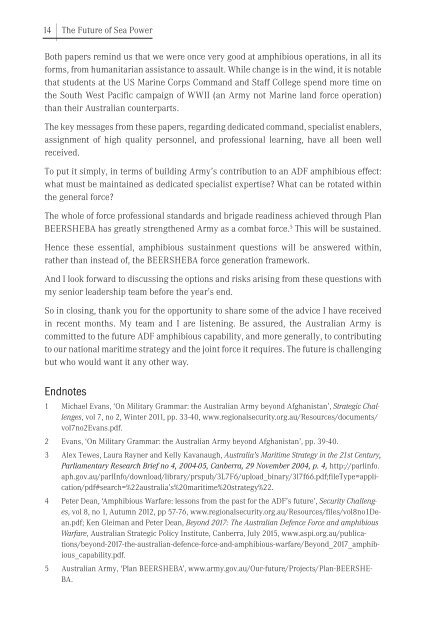THE FUTURE OF SEA POWER
SPC2015_Proceedings
SPC2015_Proceedings
You also want an ePaper? Increase the reach of your titles
YUMPU automatically turns print PDFs into web optimized ePapers that Google loves.
14 |<br />
The Future of Sea Power<br />
Both papers remind us that we were once very good at amphibious operations, in all its<br />
forms, from humanitarian assistance to assault. While change is in the wind, it is notable<br />
that students at the US Marine Corps Command and Staff College spend more time on<br />
the South West Pacific campaign of WWII (an Army not Marine land force operation)<br />
than their Australian counterparts.<br />
The key messages from these papers, regarding dedicated command, specialist enablers,<br />
assignment of high quality personnel, and professional learning, have all been well<br />
received.<br />
To put it simply, in terms of building Army’s contribution to an ADF amphibious effect:<br />
what must be maintained as dedicated specialist expertise? What can be rotated within<br />
the general force?<br />
The whole of force professional standards and brigade readiness achieved through Plan<br />
BEERSHEBA has greatly strengthened Army as a combat force. 5 This will be sustained.<br />
Hence these essential, amphibious sustainment questions will be answered within,<br />
rather than instead of, the BEERSHEBA force generation framework.<br />
And I look forward to discussing the options and risks arising from these questions with<br />
my senior leadership team before the year’s end.<br />
So in closing, thank you for the opportunity to share some of the advice I have received<br />
in recent months. My team and I are listening. Be assured, the Australian Army is<br />
committed to the future ADF amphibious capability, and more generally, to contributing<br />
to our national maritime strategy and the joint force it requires. The future is challenging<br />
but who would want it any other way.<br />
Endnotes<br />
1 Michael Evans, ‘On Military Grammar: the Australian Army beyond Afghanistan’, Strategic Challenges,<br />
vol 7, no 2, Winter 2011, pp. 33-40, www.regionalsecurity.org.au/Resources/documents/<br />
vol7no2Evans.pdf.<br />
2 Evans, ‘On Military Grammar: the Australian Army beyond Afghanistan’, pp. 39-40.<br />
3 Alex Tewes, Laura Rayner and Kelly Kavanaugh, Australia’s Maritime Strategy in the 21st Century,<br />
Parliamentary Research Brief no 4, 2004-05, Canberra, 29 November 2004, p. 4, http://parlinfo.<br />
aph.gov.au/parlInfo/download/library/prspub/3L7F6/upload_binary/3l7f66.pdf;fileType=application/pdf#search=%22australia’s%20maritime%20strategy%22.<br />
4 Peter Dean, ‘Amphibious Warfare: lessons from the past for the ADF’s future’, Security Challenges,<br />
vol 8, no 1, Autumn 2012, pp 57-76, www.regionalsecurity.org.au/Resources/files/vol8no1Dean.pdf;<br />
Ken Gleiman and Peter Dean, Beyond 2017: The Australian Defence Force and amphibious<br />
Warfare, Australian Strategic Policy Institute, Canberra, July 2015, www.aspi.org.au/publications/beyond-2017-the-australian-defence-force-and-amphibious-warfare/Beyond_2017_amphibious_capability.pdf.<br />
5 Australian Army, ‘Plan BEERSHEBA’, www.army.gov.au/Our-future/Projects/Plan-BEERSHE-<br />
BA.


